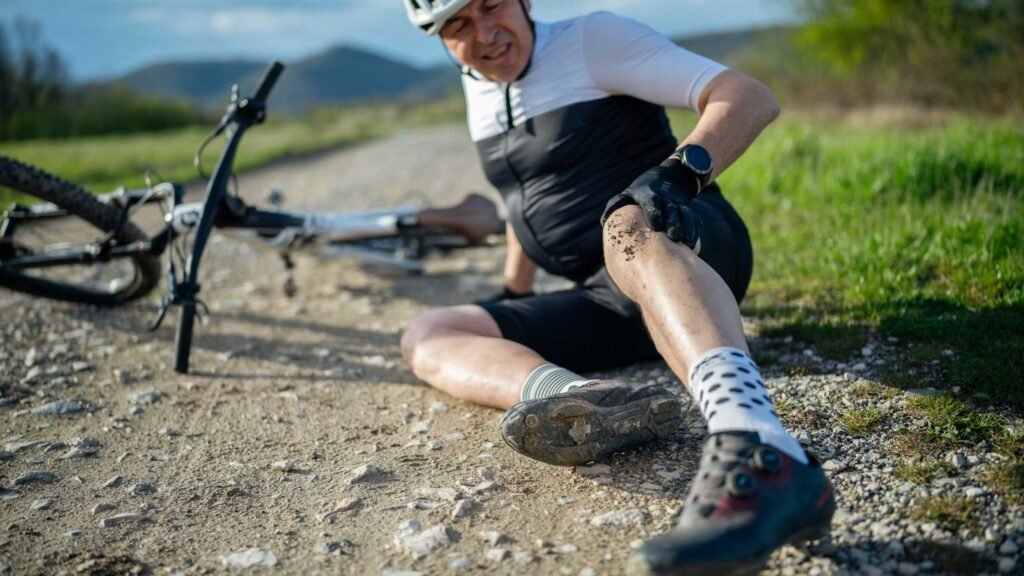Mountain biking is an incredible sport — no doubt. But like every good thing, mountain biking has its own disadvantages that you should know before you go all-in.
Now, don’t get me wrong, I love this sport. But I’m telling you the truth. It involves many disadvantages, such as Injury risks, high costs, and many more that most riders never talk about.
1. Injuries Are Common — Even Among Experienced Riders

The first and the most obvious one — injuries.
It doesn’t matter how skilled you are; accidents will still happen. (Yes, frequency will be less.)
If you’re riding a mountain bike, especially on rough trails, you will face small crashes and falls.
Sometimes it’s a simple scratch, but sometimes it can be serious — a sprain, dislocated shoulder, or even a broken collarbone.
If you’ve been reading around, you’ll know from my article on mountain biking injuries that mountain biking involves a lot of quick reactions, sharp turns, and unpredictable terrain.
Even small mistakes can lead to falls, especially when you’re riding downhill.
Overuse Injuries
Then there’s another side — overuse injuries.
These don’t come from one crash but from continuous strain.
If you ride daily or train aggressively, you might feel pain in your knees, wrists, or lower back.
It usually happens when you don’t stretch or maintain your bike properly. (Check mountain bike warm-up exercises to reduce such issues.)
Recovery Time
One more thing — injuries take time to heal. Even a minor one can keep you off the bike for a week or two.
And when you don’t ride for a long time, your stamina drops, and it takes time to get back in shape.
So yes, injuries are part of this sport — you can’t escape them, but you can minimize them with good gear and safety habits.
2. It’s an Expensive Hobby

One thing you realize pretty fast is — mountain biking isn’t cheap.
If you’ve read my post on types of mountain bikes, you already know that bikes themselves cost a lot.
Even a decent hardtail might start around $800–$1,000, and if you want a full-suspension, you’re looking at double that.
Then there’s more — helmets, gloves, pads, shoes, glasses, hydration packs… the list goes on.
Maintenance Costs
Every ride will put wear on your bike. Chains stretch, brake pads wear out, and your tires lose tread.
That’s why you’ll always have to clean and maintain your bike after every few rides.
Check my full guide on mountain bike maintenance if you want to avoid those mid-trail breakdowns.
Even cleaning your drivetrain or checking tire pressure regularly will save you a lot in the long run.
And still, you’ll have to replace components like chains, derailleurs, or tires quite often — because trails are rough, mud and dust get everywhere.
Upgrades Never Stop
When you start mountain biking, you’ll always want better — better suspension, lighter tires, carbon frames, clipless pedals, etc.
If you’re confused between pedal types, you can check this guide — Clipless vs Flat Pedals.
It’s a never-ending loop of upgrades, and that means more money.
3. Risk of Overtraining and Fatigue
Mountain biking is physical. And I mean really physical.
If you’re new or not used to intense workouts, you’ll get tired quickly, especially on long climbs.
You might even feel your legs burning halfway through the trail.
But that’s normal — every biker goes through this.
To improve, you need stamina and cardiovascular endurance, which takes time.
You can follow my guide on mountain bike training program, or read build stamina for mountain biking to train smarter.
Overtraining
The other problem is the opposite — some riders push too hard.
They don’t rest enough, ride every day, and then end up getting tired, weak, or even injured.
I always tell people that rest is as important as training.
You can’t build stamina overnight; it takes consistent effort and recovery.
So if you’re planning to ride daily, make sure you eat properly, stretch, and have rest days. You even consider having anti Inflammatory Hot Chocolate before bed.
4. Trails Aren’t Always Easy to Find

Another disadvantage — not everyone has trails nearby.
Some people are lucky enough to live near forests or hilly areas.
But if you don’t, then every ride means loading your bike, driving, and then unloading it again.
And not just that — some trails close during winters or rainy seasons because of mud, landslides, or maintenance work.
If you’re traveling, always check local conditions using apps like Trailforks or read my post on local mountain bike trails.
Riding on wet trails can damage both your bike and the environment. So it’s better to check first.
5. Weather Can Ruin Your Plan

Weather plays a big role in mountain biking.
If it rains heavily, the trails get muddy and slippery. If it’s too hot, you get dehydrated easily.
Unlike gym workouts or indoor cycling, mountain biking depends on weather conditions.
That’s why you must always prepare — wear the right mountain biking clothes (read here), carry a water bottle, and avoid risky conditions.
If you live in a region with extreme winters or rain, you’ll miss a lot of riding days. That’s one disadvantage most people don’t consider until it happens.
6. Environmental Impact
We love nature, and that’s one reason we ride — to be around it.
But sometimes, our rides can hurt it too.
When you ride on muddy trails or off the main path, your tires leave marks that lead to soil erosion. That damages the trail and makes it harder for others.
If you want to learn how to ride responsibly, you can check my post on mountain bike trail etiquette.
There’s also an issue of litter — snack wrappers, bottles, etc., left behind by careless riders. It affects the environment and sometimes gets trails banned.
So one of the biggest disadvantages of mountain biking is that, if not done responsibly, it can harm the same nature we enjoy.
7. Equipment Failures on the Trail

A sudden flat tire or broken chain can ruin your ride instantly.
Imagine being miles away from your car or home, and your tire goes flat — frustrating, right?
That’s why you must always carry tools and spares. Check this quick guide on how to fix a mountain bike flat tire.
Even better, keep a small mountain bike pre-ride checklist (see here) before every trip to make sure everything is good — tire pressure, brakes, and gears.
I personally do this every time because small problems like loose brakes or dry chains can easily cause crashes.
8. It’s Time-Consuming
Mountain biking is not like running, where you can go for 15 minutes and come back.
It’s an entire process; you’ll have to prepare your gear, check your bike, load it into your car, reach the trail, ride, and then clean everything when you’re back.
Besides this, you will also have to do regular bike maintenance, like cleaning your clothes, washing your bike, and recovering, etc.
So, mountain biking is not physically and mentally demanding. It is also a time-consuming sport.
So if you are doing a job or have a family and kids, it might not be easy to balance everyday riding.
9. Fear & Mental Stress
MTB won’t only challenge your body, but also your mind.
When you’ll ride on steep descents or rocky paths, you’ll feel fear initially.
Even after months of riding, it won’t go away completely — you just learn to manage it better.
Sometimes that fear keeps you from trying new trails. And sometimes, you push too hard and crash because of overconfidence.
It’s a sport that constantly challenges you mentally — and not everyone handles it easily.
Still, I believe it’s part of the learning curve. Fear keeps you alert, but too much fear can stop your progress.
10. You Can Get Addicted
Yes, that’s another side effect.
Mountain biking can become addictive, especially if you love thrills, adrenaline, and the post-ride high.
Once you get into it, you’ll always want to go again, ride harder, go faster.
But this can also lead to ignoring rest days, skipping family time, or spending too much on upgrades.
That’s why I always tell people — enjoy it, but keep a balance.
If you feel you’re riding every single day and losing motivation elsewhere, take a short break. You’ll come back fresher and stronger.
11. It’s Not Beginner-Friendly Everywhere
Mountain biking is not like regular cycling. It needs proper skill, balance, and coordination.
If you’re totally new, you’ll have to learn body positioning, braking, shifting, and turning. You can learn all these steps from my post on mountain biking skills.
Even small mistakes like braking too hard or leaning incorrectly can cause falls.
So, the learning curve is steep, and that’s why some beginners feel frustrated.
If you’re above 40 and starting new, don’t worry. You can still do it safely — read starting mountain biking at 40 for some helpful tips I shared earlier.
12. Weather, Travel, and Gear Storage
Let’s not forget the small but real stuff — space and travel.
Your bike and gear take up space. You’ll need a safe place to store your bike, especially if it’s an expensive one.
And if you travel a lot to trails, you’ll need a car rack, tools, and sometimes overnight plans.
So, it’s not a sport you can just start and forget. It becomes a part of your lifestyle — your home, your car, and your time all get involved.
But if you really like mountain biking, these things won’t feel like a burden.
Final Thoughts
Mountain biking gives you freedom, but it also asks for responsibility, preparation, and patience.
It can hurt, it can cost, and sometimes it will frustrate you. But once you start improving, the joy you get is hard to explain.
So yes, there are disadvantages — injuries, costs, maintenance, time — but they are all part of the process.
And you just want to take some precautions, ride smartly, and stay consistent. By doing so, you’ll get more benefits of mountain biking than disadvantages.

Ali is the founder of Mountain Bike Insider and an passionate rider with years of hands-on experience in mountain biking. From testing gear to exploring trails, Ali writes based on real riding knowledge to help others make smart, safe, and enjoyable biking choices. Every guide is built on research, personal use, and a passion for the sport.







